How Molecular Gastronomy Works
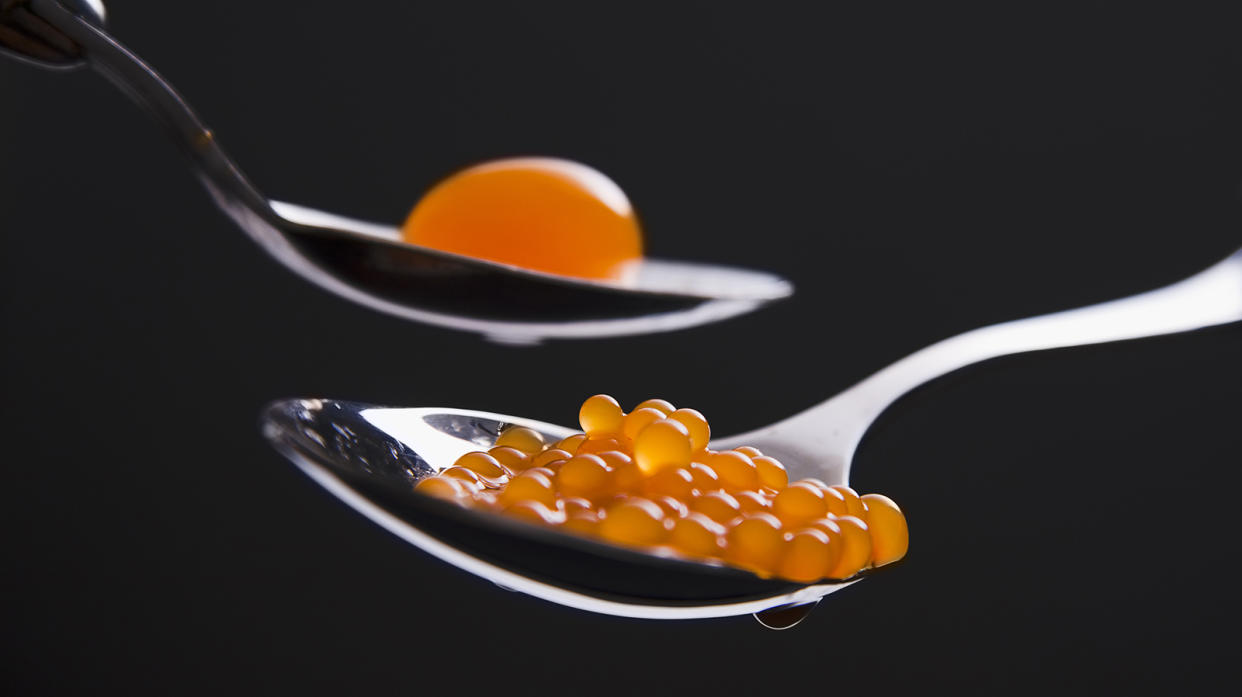
Even if your culinary credentials do not extend past boiling pasta and dumping them with canned tomato sauce, you undoubtedly have heard your share of cooking rules and old wives' tales. Have you ever wondered if those time-honored techniques work?
Molecular gastronomy takes those musings to the nth degree. Why do they or don't those age-old methods work? What are the chemical and physical processes for what's happening to the food as it cooks, and how can they be manipulated?
Read on to learn more about molecular cooking, a practice that looks at the scientific principles that take root during culinary processes.
The Origins of Molecular Gastronomy
Inspired by a soufflé disaster in his kitchen, French physical chemist Hervé This began to wonder about culinary transformations. The cheese soufflé recipe he was following gave strict instructions: Add the egg yolks two at a time. This, however, added in all of the yolks together and suffered the consequences.
Instead of giving up on soufflés, This started studying them, analyzing conventional wisdom to see what worked and what didn't. Soon, he was collecting "cooking precisions" — rules like the one given for preparing soufflé above — for a variety of dishes.
As he did, This began to realize that the culinary world had ignored a systematic, scientific study of food preparation.
He set out to change that. This partnered with Nicholas Kurti, emeritus professor emeritus of physics at Oxford University, and the two physical scientists launched a new scientific discipline: molecular gastronomy.
Cooking Science Catches On
At first, the field attracted few devotees. Then, as the two demonstrated that understanding the science of cooking could lead to amazing culinary creations, chefs and foodies began to salivate.
Today, several renowned chefs have embraced molecular gastronomy to concoct seemingly bizarre dishes that are shockingly delicious. Consider snail porridge, what one diner has described as "successively savory, sweet, snaily, crunchy and tart … nothing less than magical" [source: The Independent]. Or nitro-scrambled egg-and-bacon ice cream. These are just some of the delights that await the molecular gastronomist.
But what exactly is molecular gastronomy? Is it science? If so, how can science revolutionize what is generally considered an artistic endeavor?
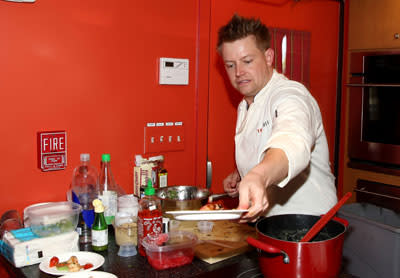
Molecular Gastronomy: Art vs. Science
The term "molecular gastronomy" is relatively new and has caused much confusion and controversy. Some of the confusion comes from trying to put a modern spin on a much older word. That word is "gastronomy," which, since the 19th century, has described the art of selecting, preparing, serving and enjoying fine food.
If preparing food is an art form, then it must be an activity requiring creative skill and imagination, not technical expertise. And yet gastronomy, like astronomy and agronomy, say, seems to describe a rigorous, scientific field of study.
In 1989, Nicholas Kurti and Hervé This decided to intentionally emphasize the scientific elements of cooking by coining the term "molecular and physical gastronomy." The addition of the words "molecular" and "physical" cast cooking in a new light. It was no longer magic and artistry, but molecules obeying well-known processes that describe the behavior of all solids, liquids and gases.
Suddenly, the "art" of selecting, preparing, serving and enjoying fine food became the "science" of doing so.
This described molecular and physical gastronomy as the physics and chemistry behind the preparation of a dish, and he began testing the scientific validity of cooking rules and old wives' tales in a research environment that was part kitchen, part high-tech lab.
He also organized the first International Workshop on Molecular and Physical Gastronomy in 1992 and presented the first doctorate in molecular and physical gastronomy at the University of Paris in 1996.
Criticisms of Molecular and Physical Gastronomy
Not everyone embraced the field. Some critics complained that the new field overemphasized the scientific processes of cooking and failed to acknowledge intangible aspects of the craft, such as a chef's intuition or spontaneity. Others simply said it was too difficult and complex for everyday cooks in average kitchens.
William Sitwell, the editor of Waitrose Food Illustrated, is one such critic has been William Sitwell. Sitwell argues that the modern interpretation of gastronomy lies beyond the grasp of most food lovers and home cooks.
Even Heston Blumenthal, who applies the science of cooking to great success, has questioned the accuracy of the term.
Molecular Gastronomy Kit
While this culinary style might not be the most accessible for everyday cooks, retailers do sell kits so that anyone can try molecular gastronomy techniques in their own homes.
Just Molecular Gastronomy
In 1998, after Nicholas Kurti passed away, Hervé This officially changed the name of the fledgling field from molecular and physical gastronomy to just molecular gastronomy. He also began to ease his strictly scientific definition of the field.
Today, This acknowledges that cooking involves more than just science and technology. It also involves art and love — components that aren't so easily described by the behavior of atoms and molecules.
In this new framework, molecular gastronomy is more properly defined as the "art and science" of selecting, preparing, serving and enjoying food. Others prefer a more fanciful definition, such as the science of deliciousness, which suggests that perception and emotion are just as important in cooking as physics and chemistry.
The emotional side of cooking may be difficult to quantify, but we gain a better understanding of the science every day.
It's Not Food Science
Molecular gastronomy isn't the same as food science, which analyzes the chemical makeup of food and develops methods to process food on an industrial scale.
Molecular gastronomy takes advantage of many of the same scientific principles, such as the use of emulsifiers, but unlike traditional food science, does it on a much smaller scale. In this respect, you could consider molecular gastronomy a branch of food science.
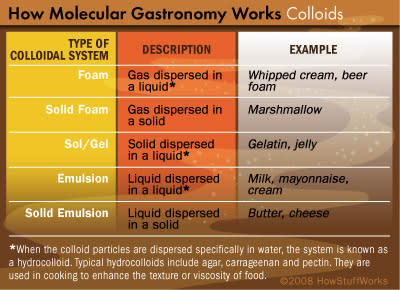
Colloids and Cooking
Chemists classify all matter into three groups: elements, compounds and mixtures. An element, such as carbon, hydrogen or oxygen, can't be broken down into other substances. A compound happens when two or more elements join chemically in a definite proportion.
Compounds — such as water, ammonia and table salt — have properties that are separate and distinct from their constituent elements. Finally, a mixture is a combination of substances that aren't held together chemically and, as a result, you can separate them by physical means, such as filtration or sedimentation.
All prepared food dishes are examples of a mixture known as a colloid. A colloid is a material composed of tiny particles of one substance that are dispersed, but not dissolved, in another substance. The mixture of the two substances is a colloidal dispersion or a colloidal system.
The colloidal systems described above involve only two phases or states of matter — gas and liquid or solid and liquid. Sometimes, especially in food preparation, there are more than two phases. Such a colloidal system is a complex disperse system, or CDS.
The classic example is ice cream, which you make by churning a mixture of milk, eggs, sugar and flavorings as it slowly chills. The churning disperses air bubbles into the mixture by foaming and breaks up large ice crystals. The result is a complex substance involving solids (milk fats and milk proteins), liquids (water) and gases (air) in at least two colloidal states.
To aid in the description of complex disperse systems found in food preparation, Hervé This devised a method — a CDS shorthand, if you will — that cooks could use for any dish.
His method abbreviates phases with letters and uses symbols and numbers to represent processes and sizes of molecules, respectively. For example, you write the shorthand for aioli sauce, a mayonnaise-like emulsion of olive oil flavored with lemon juice and garlic, as:
O[10-5, 10-4] ÷ W[d > 6 x 10-7]
The O stands for "oil," the W for "water." The forward slash means "dispersed into." The numbers indicate the sizes of the molecules.
Showing molecule sizes is important because the size of solid particles in a colloid helps determine its properties. The particles dispersed in milk range from 3.9 x 10-8 to 3.937 x 10-5 inches (1 x 10-7 to 1 x 10-4 centimeters) in diameter.
After developing his system, Hervé This undertook a thorough analysis of French sauces. Most cookbooks will tell you that there are hundreds of French sauces — generally classified into white sauces, brown sauces, tomato sauces, the mayonnaise family and the hollandaise family.
This discovered that all the French classical sauces belong to only 23 groups based on the type of CDS used to make the sauce. Not only that, This found that it was possible to move backward from a formula to a brand-new sauce never before prepared in any kitchen. In other words, you can use This' CDS system to invent new recipes from scratch.
Understanding colloids is just the beginning. Molecular gastronomists take advantage of other scientific principles to prepare world-class dishes. We'll cover those next.
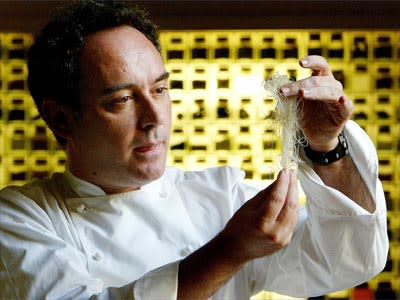
Sous Vide Cooking
Molecular cuisine requires special techniques, ingredients and cooking principles to encourage certain chemical reactions to occur. These reactions, in turn, produce startling new flavors and textures. One popular technique is cooking meat "sous vide," a French term that means "under vacuum."
Here's how sous vide cooking works with meat:
First, you pour water in a pan and heat it to a low temperature. The exact temperature varies depending on the type and thickness of the meat, but it never exceeds the boiling point of water (212 degrees F, 100 degrees C). For steak, the water temperature is about 140 degrees F (60 degrees C).
Next, you place your meat, along with seasonings, into a heat-safe plastic bag, seal it and place it in the hot-water bath.
The meat cooks slowly in the heated water and retains its moisture.
After approximately 30 minutes, you remove the meat from the bag and place it in a hot frying pan.
Sear the meat briefly on each side before serving.
When you cut into the meat, you will find it is juicy, tender and delicious.
Spherification
Another interesting technique is spherification, which involves making liquid-filled beads that, to use the words of a writer at Gourmet magazine, "explode in the mouth with a pleasingly juicy pop" [source: Abend]. Chef Ferran Adrià first developed the technique and has since perfected it for a variety of dishes.
Spherification relies on a simple gelling reaction between calcium chloride and sodium alginate, a gumlike substance extracted from brown seaweed.
For example, to make liquid olives, you first blend calcium chloride and green olive juice. Then, mix alginate into water and allow the mixture to sit overnight to remove air bubbles. Finally, delicately drop the calcium chloride/olive juice mixture into the alginate and water.
The calcium chloride ions cause the long-chain alginate polymers to become cross-linked, forming a gel. Because the calcium chloride/olive juice mixture enters the alginate in the shape of a droplet, the gel forms a bead.
The size of the bead can vary dramatically, making it possible to create jelly-shelled equivalents of everything from caviar to gnocchi and ravioli.
Flash Freezing
Innovative chefs use flash freezing to create fluid-filled fare. It's simple: Expose food to extremely low temperatures, and it will remain frozen on the surface, liquid in the center. Chefs typically use the technique to develop semifrozen desserts with stable, crunchy surfaces and cool, creamy centers.
At Chicago's Alinea restaurant, chef Grant Achatz used flash freezing to create a culinary delight consisting of a frozen disk of mango purée surrounding a core of roasted sesame oil.
As a San Francisco blogger and food lover relates, the dish arrives with instructions: "We were instructed to allow the whole thing to melt away on our tongues. An extraordinary dance of sweet, tangy, salty, icy, creamy, oily ..." [source: Gastronomie].
Juxtaposing Flavors
Flavor juxtaposition is one of the most important tenets of molecular gastronomy. French chemist Hervé This says juxtaposition can help intensify a more flavorful ingredient by pairing it with a much less flavorful ingredient. Or you can combine two dominant flavors, such as chocolate and orange, to reinforce the taste of both.
Either way, understanding the molecules responsible for flavors is helpful.
Molecular gastronomists have learned that foods sharing similar volatile molecules — those that leave food as a vapor and waft to our nose — taste good when eaten together. This concept has led to some unusual flavor pairings, like strawberry and coriander, pineapple and blue cheese, and cauliflower (caramelized) and cocoa.
If you want to test some of these techniques, you'll need the right equipment.
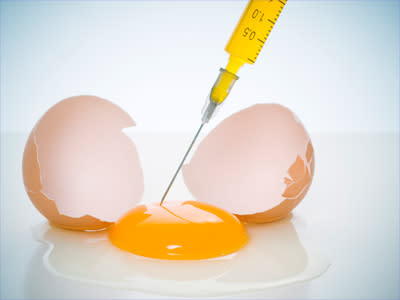
Cooking with Liquid Nitrogen, Vacuum Machines and Syringes
The recipe for liquid olives — which calls for 1.25 grams (0.04 ounces) of calcium chloride, 200 grams (7 ounces) of green olive juice, 2.5 grams (0.09 ounces) of alginate and 500 grams (18 ounces) of water — sounds more like the materials list of a high school chemistry experiment and hints at one important piece of equipment every molecular gastronomist must have: a scale.
A good digital scale is indispensable (and you can even use it for nonculinary tasks, such as evaluating nutritional content or even calculating postage).
Here are some other tools you might need to master molecular gastronomy:
Vacuum machine: Remember the sous vide steak we talked about? If you really want to do the job right, consider a vacuum sealer. A good model will evacuate the air from plastic bags and then seal the bag tightly closed. You can also buy a thermal bath to provide precise heating of your water bath.
Hypodermic syringe: You may shudder at the sight of a needle, but you may have to overcome your fear if you want to practice molecular gastronomy. Syringes are helpful in the process of spherification. Some chefs also use them to inject liquids into meat to enhance flavor and texture.
Liquid nitrogen: At a temperature of minus 321 degrees F (minus 196 degrees C), liquid nitrogen will flash freeze any food it touches. As it boils away, it gives off a dense nitrogen fog that can add atmosphere and drama to food preparation. Unfortunately, liquid nitrogen requires transportation in specially made flasks and can be dangerous if it touches the skin. A safer alternative is the Anti-Griddle, described next.
Anti-Griddle: The Anti-Griddle, a product of PolyScience, looks like a traditional cooktop, but it doesn't heat up food. Its minus 30 degrees F (minus 34 degrees C) surface instantly freezes sauces and purées or freezes just the outer surfaces of a dish while maintaining a creamy center.
The Gastrovac: Manufactured by International Cooking Concepts, the Gastrovac is three tools in one: a Crock-pot, a vacuum pump and a heating plate. In its low-pressure, oxygen-free atmosphere, the Gastrovac cooks food faster at lower temperatures, which helps the food maintain its texture, color and nutrients. When the food has warmed up, you restore the pressure and create what ICC calls the "sponge effect." The liquid rushes back into the food, bringing intense flavors with it.
Of course, you'll need to have a well-stocked spice rack to accompany your high-end gadgets. We've already discussed alginate and calcium chloride — the two chemicals needed for spherification.
Another important gelling agent is methylcellulose, which congeals in hot water, then becomes liquid again as it cools. Emulsifiers are a must for maintaining a uniform dispersion of one liquid in another, such as oil in water. Two popular emulsifiers are soy lecithin and xanthan gum.
Finally, more and more molecular gastronomists are turning to transglutaminase, a chemical that causes proteins to stick together. Because meat is protein, chefs can do inventive things with transglutaminase, such as removing all fat from a steak and gluing it back together or fashioning noodles from shrimp meat.
Now we're ready to put everything together. In the next section, we'll present three recipes for a molecular gastronomy-inspired meal.
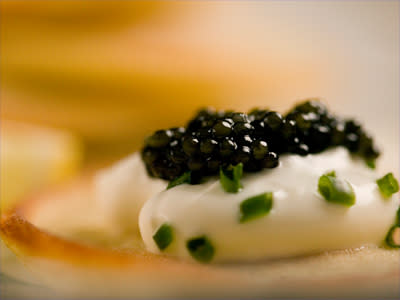
Molecular Gastronomy Recipes
It's not the goal of molecular gastronomists to reduce cooking to a collection of dry calculations and lifeless formulas. Rather inventive cooks are trying to make their creations even tastier, with the help of a new technique or by tweaking an old favorite. Let's see how they might transform this traditional meal.
The main ingredient in caviar, the classic upscale hors d'oeuvre, is the eggs of certain fish species. With a little kitchen chemistry, you can enjoy a new kind of caviar — apple caviar — first developed by Ferran Adrià, who experimented with spherification.
Apple Caviar
Here's the basic recipe; you can find detailed instructions here.
Gather one-and-a-quarter pounds of golden apples, along with some alginate, baking soda, water and calcium chloride. Puree the golden apples, freeze for half an hour and then skim off the impurities and strain. Next, add the alginate to the apple juice while heating. Remove from heat and add the baking soda.
Now prepare a calcium chloride solution by dissolving calcium chloride in water. Finally, use a syringe to add your apple juice mixture to the calcium chloride solution one drop at a time. As you do, you should see beads, or "caviar," form. Cook for a minute in boiling water, strain and rinse in a cold-water bath.
Cointreau-infused Duck
For the main course, we're going to have duck à l'orange. The classic French recipe directs you to roast the bird in an oven for about two hours.
Roasting browns the meat and adds flavor through a series of chemical changes known as Maillard reactions. These reactions cause sugars and amino acids in the meat to cross-link. This, in turn, creates the compounds responsible for the pleasing color and flavor.
Unfortunately, cooking meat at high temperatures also has some negative effects. Most notably, the muscle fibers contract and shorten, forcing out water and making the meat tougher.
A molecular gastronomist overcomes this by taking advantage of microwave technology. When prepared in a microwave, meat warms to 212 degrees F (100 degrees C) and remains at that temperature as long as it contains water.
Microwaving meat is faster and more efficient than roasting but doesn't produce the beneficial Maillard reactions. To get the best of both worlds, molecular gastronomists would brown the meat first in a skillet, inject Cointreau (an orange-flavored liqueur) into each piece with a syringe, then finish the cooking in the microwave.
Flash-frozen Vanilla Ice Cream
Homemade vanilla ice cream is last. The best ice cream has abundant air bubbles and small ice crystals, which makes the finished product light and smooth.
Traditionally, you would place your ingredients in an automatic ice cream maker to churn and freeze the mixture. Churning folds air into the material and breaks up ice crystals. But there's a limit to how cold an average machine can get. Most rely on your kitchen freezer, which reaches a temperature of 0 degrees F (-18 degrees C).
A molecular gastronomist uses a simpler technique: He or she pours liquid nitrogen directly into the ingredients, which will flash-freeze the mixture and create extra-small ice crystals that result in the smoothest ice cream possible.
If you're dying to make this classic dessert in a cutting-edge way, start with a basic recipe, like this one from the Food Network. After preparing the ice cream mixture, don your safety glasses and gloves and add liquid nitrogen while stirring with a wooden spoon. Stop when the ice cream reaches your desired thickness.
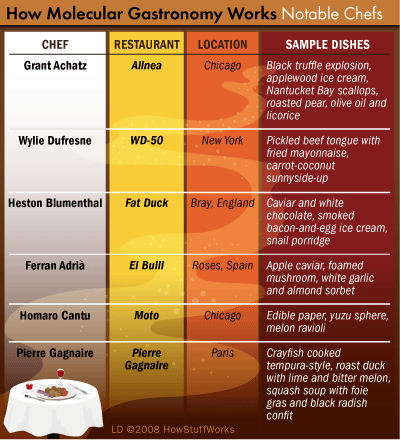
Becoming a Molecular Gastronomist
Anyone can learn and apply the techniques of molecular gastronomy to basic dishes and preparations. For instance, contrary to popular belief, adding oil to boiling water does not prevent pasta from clumping.
Why? Because oil and water don't mix, which means the oil stays on the surface, far from the cooking noodles. Instead, add a tablespoon of something acidic, such as vinegar or lemon juice. A weak acid inhibits the breakdown of starch and reduces stickiness.
For many people, this will be the extent of their hands-on involvement with molecular gastronomy. But that doesn't mean they won't appreciate the products of molecular gastronomy. Luckily, there are several chefs around the world who readily embrace physics and chemistry in the kitchen.
The accompanying table lists some of the most renowned chefs who apply the principles and techniques of molecular gastronomy. But be forewarned: If you decide to visit one of these restaurants, you'll need to make reservations weeks or even months in advance. You should also be prepared to pay handsomely — $200 a head or more — for the experience.
If, after dining at one of these molecular gastronomy hotspots, you decide you want to become an avant-garde chef yourself, there are options.
A few universities are introducing molecular gastronomy programs for postgraduate students. And several cooking schools are also incorporating molecular gastronomy in their courses. At the French Culinary Institute in New York City, students can learn about sous vide techniques, hydrocolloids and other applications of food and technology.
Either way, as a student of cooking or as a lover of fine food, molecular gastronomy is sure to open up new vistas — and awaken your palate to a new definition of delicious.
Lots More Information
Related HowStuffWorks Articles
Sources
Andres, Jose. "Spherification 101." StarChefs.com. November 2007. (Dec. 26, 2008) http://starchefs.com/events/studio/techniques/JAndres/index.shtml
Barnes-Svarney, Patricia, ed. "The New York Public Library Science Desk Reference." Macmillan. 1995.
Davidson, P. Michael. "Food Additive." World Book Multimedia Encyclopedia. 2004.
"Gastronomy." Encyclopedia Britannica CD-ROM. 2005.
Hesser, Amanda. "Under Pressure." New York Times. Aug. 14, 2005. (Dec. 26, 2008)http://www.nytimes.com/2005/08/14/magazine/14CRYOVAC.html?pagewanted=1&_r=2
Hogg, R. "Colloid." World Book Multimedia Encyclopedia. 2004.
King, Émilie Boyer. "Food: his passion, his science." The Christian Science Monitor. Feb. 18, 2004. (Dec. 26, 2008)http://www.csmonitor.com/2004/0218/p11s02-lifo.html
Kurti, Nicholas and Hervé This. "Chemistry and Physics in the Kitchen." Scientific American. April 1994.
Lempert, Phil. "What exactly is molecular gastronomy?" MSNBC. May 20, 2008. (Dec. 26, 2008)http://www.msnbc.msn.com/id/24740136/
McGrane, Sally. "The Father of Molecular Gastronomy Whips Up a New Formula." Wired. July 24, 2007. (Dec. 26, 2008)http://www.wired.com/techbiz/people/magazine/15-08/ps_foodchemist
McLaughlin, Lisa. "Home Cooks, Meet Molecular Gastronomy." Time. Nov. 13, 2008. (Dec. 26, 2008)http://www.time.com/time/magazine/article/0,9171,1858877,00.html
Pain, Elisabeth. "Molecular Gastronomy: Something's Cooking." Science Careers. Nov. 2, 2007. (Dec. 26, 2008)http://sciencecareers.sciencemag.org/career_development/previous_issues/articles/2007_11_02/caredit_a0700157
Palmer, Sharon. "Molecular Gastronomy -- Discovering the 'Science of Deliciousness.'" Today's Dietician. Vol. 8, No. 5. (Dec. 26, 2008)http://www.todaysdietitian.com/newarchives/may2006pg44.shtml
Raiswell, James. "Molecular Gastronomy." AskMen.com. (Dec. 26, 2008) http://www.askmen.com/fine_living/wine_dine_archive_150/195_wine_dine.html
Sitwell, William. "Hallelujah for Delia and an end to Britain's food snobbery." The Daily Mail. Feb. 11, 2008. (Dec. 26, 2008)http://www.dailymail.co.uk/news/article-513770/Hallelujah-Delia-end-Britains-food-snobbery.html
This, Hervé. "Food for tomorrow? How the scientific discipline of molecular gastronomy could change the way we eat." EMBO reports 7. 2006. (Dec. 26, 2008)http://www.nature.com/embor/journal/v7/n11/full/7400850.html
Wells, Pete. "Eat 300 and Say 'Spherification.'" New York Times. Feb. 20, 2008. (Dec. 26, 2008)http://www.nytimes.com/2008/02/20/dining/20coint.html
Original article: How Molecular Gastronomy Works
Copyright © 2023 HowStuffWorks, a division of InfoSpace Holdings, LLC, a System1 Company

 Yahoo News
Yahoo News 
